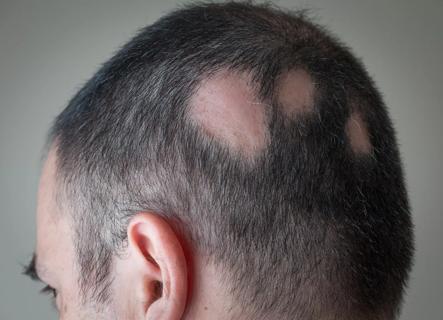Many treatment options provide hope

Baldness is a hot topic in research. Androgenetic alopecia (AGA), or male pattern baldness, is the most common type of progressive hair loss disorder in men.
Advertisement
Cleveland Clinic is a non-profit academic medical center. Advertising on our site helps support our mission. We do not endorse non-Cleveland Clinic products or services. Policy
Half of the men in the world experience hair loss by age 50. About 70% of men will lose hair as they get older. And 25% of bald men see first signs of hair loss before age 21.
“Recent advances offer a lot of hope in both treating and preventing different types of baldness,” says dermatologist Amy Kassouf, MD. For example, researchers can now grow hair follicles in a lab. Some are even studying new cancer treatments that make hair grow instead of falling out.
But if you’re thinking about waiting for these trials to conclude final findings in the near future, there’s still a way to go.
Until then, here are some facts and common questions about male pattern hair loss that can help clear up any misconceptions you might have.
You inherit the genes for baldness. The occurrence and development of androgenetic alopecia depends on the interaction of endocrine factors and your genetic predisposition. So if your dad or uncle are bald, chances are good you can’t escape a similar fate.
You reach puberty and produce androgens (sex hormones). If you’re genetically predisposed, these interact with your genes to miniaturize the hair follicles. Your normal hair then falls out. It is replaced by tiny, non-pigmented hairs (barely visible fuzz). This process occurs across your scalp until it’s run its course. Eventually, the follicles go dormant and stop producing even fuzz.
Advertisement
Male pattern baldness begins at the temples, front of the scalp and crown of the head. Over the course of months or years, bald areas of the scalp meet and conjoin. The result is the familiar “crown of laurel” shape.
Have you ever noticed that men who are bald still have tufts of hair below their ears? For some reason, this section of hair is genetically programmed not fall out.
There are pharmaceutical, surgical and cosmetic treatments treatments for baldness.
Topical minoxidil (Rogaine) and finasteride (Propecia) are the only drugs approved by the FDA to treat pattern baldness.
Minoxidil is a vasodilator that is also used to treat high blood pressure. When used to treat hair loss, it widens blood vessels and provides more blood flow to the hair follicles. This is applied directly to the scalp.
Oral finasterides (FNS) are synthetic compounds that block the conversion of testosterone to dihydrotestosterone (DHT). These are the most common treatments for male pattern baldness and general alopecia.
But, keep in mind and your doctor should discuss with you the side effects associated with finasterides such as:
One recent study also shows a possible effectiveness of treatments containing quercetin — a component found in Houttuynia cordata extract. It’s one of the important markers in hair follicle and cell survival.
A new 2020 study also suggests that botulinum toxin type A (BTA) may show promise to be effective in treating AGA. It has been studied and shown to be a safe and effective therapeutic strategy for the treatment of AGA without adverse effects.
The most reliable and effective treatments are provided by doctors or under doctor supervision in a healthcare setting, so talk to your doctor to see if any are right for you.
These are the most common solutions for balding that deal directly with cosmetically or physically altering your appearance:
Advertisement
Baldness affecting the crown of the head (vertex) is associated with an increased risk for coronary heart disease, so talk to your doctor about the link between the two.
There have also been many studies that question if baldness is also associated with a higher risk of prostate cancer. However, recent studies suggest that baldness is not a consistent biomarker for prostate cancer risk or progression.
Research is still underway about prevention and treatment, so there’s hope for the future. But until then Dr. Kassouf recommends shifting your focus to working with the resources you’ve got.
“Instead of wasting your money on products that claim to but don’t work, focus your efforts on finding a new style that suits you — with less hair. The best strategy is to embrace your hair loss,” says Dr. Kassouf.
“While it’s true there are pharmaceutical and cosmetic developments that can help you address your physical appearance concerns, each comes with its own set of positives and negatives. Always talk with your doctor before you consider any treatments.
Advertisement
Learn more about our editorial process.
Advertisement

Take steps to reduce stress by practicing meditation, finding time to relax and maintaining a healthy lifestyle

You may see pitting, brittleness or ridges in your fingernails and toenails

Your immune system may attack hair follicles anywhere on your body

It’s normal to lose around 50 to 150 strands per day to routine hair shedding

Studies are mixed, but frequently wearing very tight, warm hats could stress your follicles and lead to hair loss

Things like stress, heated styling and other health conditions may cause you to lose more hair than normal

Creatine does cause some side effects, but hair loss probably isn’t one of them

A gentle hair care routine, stress reduction and sun protection can help reduce flares and maintain your locks

Start having sex about 72 hours before ovulation, then at least every other day during your fertile window

Attachment theory suggests that your earliest relationships shape connections throughout your life

It isn’t a recognized mental health disorder, but research shows that problematic social media use can negatively affect your mental health, self-esteem and sleep